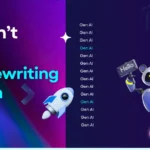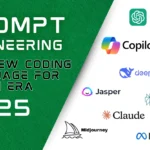
1. Introduction to Prompt Engineering
Prompt engineering is the practice of carefully designing instructions, or “prompts,” to guide artificial intelligence (AI) tools like ChatGPT or Copilot to generate high-quality, relevant outputs. Instead of writing lines of code, users compose sentences or structured inputs that tell the AI exactly what to do.
Why It’s Gaining Momentum
As generative AI models revolutionize everything from content creation to code generation, prompt engineering is emerging as a critical skill across industries. A 2024 McKinsey report noted that about 75% of organizations piloting generative AI believe that prompt engineering improves output quality and productivity.
2. How to Create Effective Prompts for ChatGPT, Copilot, Perplexity, Gemini, DeepSeek, and Grok?
Creating an effective prompt—especially for AI tools like ChatGPT, image generators, or code assistants—means being clear, specific, and goal-oriented. Here’s a simple guide to help you craft powerful prompts:
Be Clear and Specific
Avoid vague requests. Clearly state what you want.
Bad Prompt:
“Write something about marketing.”
Better Prompt:
“Write a 100-word Instagram caption promoting a digital marketing workshop for beginners.”
Provide Context
The more background you give, the better the response.
Example:
“I run a bakery that specializes in vegan cakes. Write a social media ad that highlights our new gluten-free menu.”
Include Format or Style (if needed)
Tell the AI the format: list, email, tweet, poem, code, etc.
Example:
“Create a bullet list of 5 benefits of using AI in business.”
Define the Goal
What are you trying to achieve? Inform, entertain, sell, summarize?
Example:
“Summarize this 1,000-word blog post into 3 bullet points for a LinkedIn update.”
Add Constraints
Word count, tone, audience, or platform.
Example:
“Write a funny 10-second YouTube Shorts script about forgetting your Wi-Fi password.”
Use Examples (if needed)
If you’re asking for something complex, give a sample.
Example:
“Create a prompt like this one: ‘Describe a futuristic city with eco-friendly architecture and AI-powered transport systems.’”
3. The Rise of Generative AI
From ChatGPT and Copilot to Google Gemini, generative AI tools are transforming how humans interact with software and data. Copilot, for example, accelerates software development by suggesting code in real-time, while ChatGPT helps users write emails, summarize data, and debug scripts.
Why Crafting Precise Prompts Matters:
Research shows that vague prompts lead to less accurate outputs, while clear, detailed prompts improve answer quality and save time by minimizing the need for rework.
For instance, Salesforce found that employees using optimized prompts with ChatGPT completed customer responses 29% faster.
4. Prompt Engineering vs Traditional Programming
| Aspect | Prompt Engineering | Traditional Programming |
| Approach | Natural language commands | Writing detailed code |
| Speed | Fast adjustments | Slower, structured process |
| Control | Bounded by AI behavior | Full, deterministic control |
| Use Cases | AI tasks, content, prototyping | Complex systems, business rules |
| Learning Curve | Moderate (AI-focused) | Steep (coding expertise needed) |
| Cost | Lower (fewer resources) | Higher (specialized skills) |
This explains how working with AI using prompts is different from regular coding. Instead of writing detailed code, prompt engineering focuses on giving clear instructions in natural language to guide AI models, which makes it a powerful low-code/no-code approach.
This helps even non-programmers use AI effectively, while traditional programming requires deeper technical skills to create software from scratch.
5. Benefits and Disadvantages of Prompt Engineering
Key Advantages
- Easy to Use (Low-Code/No-Code): Prompt engineering lets people without coding skills use AI by giving clear instructions in plain language. This makes AI accessible to many professionals.
- Fast and Efficient: Good prompts help AI give quick and accurate answers, saving time and reducing the need for constant human checks or retraining.
- Better Accuracy: Well-designed prompts can improve AI’s performance by up to 20%, and techniques like Chain-of-Thought can boost reasoning accuracy by around 30%.
- Scalable: Flexible prompts let AI handle new problems easily, helping organizations reuse AI tools across different teams or projects.
Limitations and Challenges
- Ambiguity: Natural language can be unclear. For instance, “Write about a bank” could mean a money bank or riverbank, confusing the AI.
- Overfitting: Sometimes AI gets too used to a specific prompt and struggles with different or new prompts.
- Hallucinations: AI might make up false information or facts, which happens around 27% of the time in some cases.
- Inconsistency: Small changes in prompts can cause big differences in AI responses, making it hard to get steady, reliable results.
6. Types of Prompts
Instructional Prompts
These are direct commands that tell the AI what to do. Examples include “Write a blog post about renewable energy” or “Summarize this document in three bullet points”. Instructional prompts work best when they are specific and include context about the desired output format, tone, and audience.
Zero-Shot Prompts
Zero-shot prompting means providing a prompt without any examples, relying entirely on the model’s pre-training to understand and respond.
For example:
Prompt: “Classify the text into neutral, negative or positive. Text: I think the vacation is okay. Sentiment:”
Output: “Neutral”
Zero-shot prompting is ideal for generalized tasks and offers high scalability since it requires no additional preparation.
Few-Shot Prompts
Few-shot prompting includes one or more examples to guide the model’s response. This technique significantly improves performance on complex tasks by showing the AI the desired pattern:
Example:
Translate English to French:
English: Hello, how are you?
French: Bonjour, comment ça va ?
English: What is your name?
French: Comment tu t’appelles ?
English: I would like a coffee.
French:
Output: ” Je voudrais un café.”
Chain-of-Thought Prompts
Chain-of-Thought (CoT) prompting guides the AI through step-by-step reasoning before providing a final answer. This technique is particularly effective for complex problem-solving tasks:
Example:
The odd numbers in this group add up to an even number: 15, 32, 5, 13, 82, 7, 1.
A: Adding all the odd numbers (15, 5, 13, 7, 1) gives 41. The answer is False.
CoT prompting improves accuracy in arithmetic, logical reasoning, and multi-step problem-solving tasks.
Role-Based Prompts
Role-based prompting assigns a specific persona or expertise to the AI, such as “Act as a UX Designer” or “You are a financial analyst”. This approach helps establish contextual boundaries and ensures behavioral consistency:
Example: “As a seasoned UI/UX designer, use your years of experience and knowledge of current trends to generate a list of innovative design concepts for a mobile banking app”.
7. Prompt Engineering Techniques
Prompt Templates
Structured templates provide consistent frameworks for different types of tasks. Effective templates typically include clear role definition, specific context, detailed task description, and desired output format. Microsoft Azure recommends using separators like “—” or triple quotes to distinguish different sections of prompts.
Step-by-Step Prompting
This technique breaks complex tasks into smaller, manageable components. Each step builds upon the previous one, creating a logical flow toward the desired outcome:
Example Process:
- Define the overall objective
- Break down into subtasks
- Execute each step sequentially
- Use output from one step as input for the next
Prompt Chaining
Prompt chaining involves linking multiple prompts where the output of one serves as input for the next. This technique is particularly useful for complex workflows:
Benefits:
- Breaks down complexity into manageable pieces
- Improves accuracy through focused attention
- Enhances explainability of the reasoning process
- Enables error handling at each step
Implementation Types:
- Sequential Chaining: Linear progression from one prompt to the next
- Conditional Chaining: Branching based on previous outputs
- Looping Chaining: Iterative refinement until criteria are met
Self-Reflection and Self-Evaluation Prompts
These advanced techniques encourage AI to critically analyze its own responses before finalizing them. Examples include:
- “Review your previous response and identify any missing points or areas that could be improved”
- “Check for any logical inconsistencies or factual errors in your response. If found, correct them”
- “Did you answer the question correctly? If not, please provide a corrected response”
This approach leads to more thoughtful, accurate, and well-developed responses by mimicking human self-review processes.
8. Prompt Engineering in Different Domains
Marketing and Advertising
Prompt engineering makes it easy to quickly create ads and plan campaigns. For example:
- Campaign Planning: “Make a marketing plan for launching a new eco-friendly fashion brand using social media and influencers.”
- Ad Copy: “Write 5 catchy Facebook headlines for a productivity app aimed at remote workers.”
- SEO: “List 10 beginner-friendly keywords for a yoga blog.”
Well-written prompts help marketers save time and boost campaign results.
Coding and Software Development
Developers use prompt engineering to speed up their work, such as:
- Code Generation: “Write a Python function for binary search, with error handling.”
- Bug Fixing: “Check this JavaScript for memory leaks and suggest fixes.”
- Code Review: “Review this React component for security and performance.”
- Documentation: “Write API docs for this REST endpoint.”
Studies show prompts can cut debugging time nearly in half and improve code quality.
Education and Tutoring
In education, prompt engineering helps personalize learning. Examples:
- Lesson Planning: “Plan a lesson on photosynthesis for 8th graders with activities and questions.”
- Quiz Creation: “Make 10 multiple-choice questions on World War II, with answer explanations.”
- Student Feedback: “Give feedback on this essay about climate change.”
- Adaptive Learning: AI tutors can change their approach based on student answers.
Legal Applications
Lawyers use prompts to review and draft documents:
- Contract Review: “Spot risks and unclear points in this software contract.”
- Legal Research: “Summarize recent court cases on health data privacy.”
- Drafting Letters: “Write a cease and desist letter for trademark violation.”
- Compliance: “Check this policy against the latest SEC rules.”
Finance and Customer Service
Prompt engineering helps banks and support teams work faster:
- Analysis: “Review this earnings report and provide key insights.”
- Risk: “Evaluate the risk of this small business loan.”
- Customer Support: “Create a step-by-step help guide for login issues.”
- Fraud Checking: “Identify possible fraud in account transactions.”
These examples show how prompt engineering saves time, improves quality, and makes AI useful in many different fields.
9. Tools and Platforms for Prompt Engineering
OpenAI Playground
A basic tool for trying out prompts with AI models like GPT-3.5 and GPT-4.
Features:
- Access to multiple AI models
- Adjustable settings like temperature and max tokens
- Instant testing and feedback
- Different modes: Chat, Complete, and Assistants
Benefits:
No installation needed, easy to use, and good for quick experiments. However, it lacks advanced prompt management and team collaboration tools for bigger projects.
Prompt Marketplaces and Communities
PromptHero
- Large collection of prompts for ChatGPT, Midjourney, DALL-E, and more
- Free access to community-created prompts
- Prompts sorted by use case and model type
- Educational content and courses on prompt engineering
FlowGPT
- Huge library of 100,000+ ChatGPT prompts
- Test prompts directly on the platform
- Fun community features like hackathons and prompt battles
- Organized for different professional uses
LangChain and Development Frameworks
LangChain is a powerful framework for building complex AI applications with prompts.
Key Features:
- Modular prompt templates
- Chains to connect multiple prompts in workflows
- Memory to keep context across interactions
- Integration with external tools and data sources
- Supports many large language model providers
Advanced Capabilities:
- Version control for prompts
- A/B testing to compare different prompts
- Support for production-level deployment
- Works with vector databases for retrieval-augmented generation (RAG)
AutoGPT Compatibility:
Enables building autonomous AI agents by combining prompt chains and tool integration.
Specialized Platforms
AIPRM:
Browser extension offering 4,000+ industry-specific prompt templates for marketing, SEO, and business tasks.
PromptBase:
Marketplace where prompt engineers can buy and sell high-quality prompts priced between $2 and $5, offering earning opportunities.
Prompt Management Tools:
Enterprise-level tools like PromptLayer help with version control, tracking experiments, and team collaboration to manage prompt workflows professionally.
10. Prompt Failures & Debugging
Common Prompt Problems & Fixes
Problems
- Vague Instructions:Too unclear, e.g., “Help me with marketing.”
- Too Much Info:Overloading causes confusion.
- Conflicting Requests:Asking for opposite things confuses AI.
How to Fix
- Find the exact problem.
- Change one thing at a time.
- Keep everything else the same.
- Look for repeating errors.
Tips to Avoid Errors
- Be clear and specific, e.g., say “Write a 1,500-word sales report on electronics with trends and recommendations.”
- Give AI a role, e.g., “You are a financial analyst with 10 years’”
- Tell AI how to format answers, e.g.:
- Summary
- Key points
- Recommendations
- Risk assessment
11. Future of Prompt Engineering
Emergence of PromptOps Roles
The field is evolving toward specialized operational roles similar to DevOps. PromptOps professionals focus on:
- Systematic prompt development and testing
- Version control for prompt libraries
- Performance monitoring and optimization
- Integration with existing software development workflows
Salary Trends: Prompt engineering roles command impressive salaries, ranging from $75,000 to $335,000 annually in the United States, often exceeding traditional programming roles. The global prompt engineering market is projected to grow at a CAGR of 32.8% between 2024-2030.
Prompt Marketplaces and Commercialization
Market Evolution: Platforms like PromptBase, PromptHero, and FlowGPT have created ecosystems where prompt engineers can monetize their expertise. High-quality prompts sell for $2-5 each, with top creators earning substantial passive income.
Enterprise Adoption: Major corporations are establishing prompt engineering teams to optimize their AI implementations. Early adopters in finance, legal, healthcare, and marketing are already employing specialized prompt engineers.
Integration with Traditional Programming
Hybrid Development Model: The future likely holds a collaborative approach where traditional programmers and prompt engineers work together:
- Prompt Engineers: Focus on AI interaction, natural language interfaces, and user experience optimization
- Traditional Programmers: Handle system architecture, performance optimization, and complex algorithmic challenges
Code Generation Evolution: Advanced prompt engineering is already enabling code generation for routine tasks, but complex systems still require traditional programming expertise.
Will Prompt Engineering Replace Coding?
The Reality: While prompt engineering is revolutionary, it won’t completely replace traditional programming:
Limitations of Prompt Engineering:
- Cannot handle high-performance computing requirements
- Lacks precision for complex system architecture
- Limited scalability for enterprise-grade applications
- Insufficient for safety-critical systems
Complementary Relationship: Prompt engineering serves as a powerful interface layer, making AI more accessible while traditional programming remains essential for:
- Operating systems and infrastructure
- Real-time systems and embedded programming
- High-performance computing applications
- Complex algorithm implementation
Future Prediction: The field is evolving toward “Natural Language Programming” – a hybrid approach where developers use both traditional coding and prompt engineering to build more intuitive, AI-enhanced applications.
12. Learning Resources & Communities
Educational Platforms and Courses
Free Resources:
- Learn Prompting: Comprehensive, open-source guide covering basics to advanced techniques
- Prompt Engineering Guide: Extensive documentation with latest papers and techniques
- OpenAI Documentation: Official best practices and implementation guides
Structured Courses:
- Vanderbilt University: “Prompt Engineering for ChatGPT” course available on Coursera
- upGrad: Advanced Prompt Engineering certification programs with industry mentorship
- PromptHero Academy: Specialized courses focusing on practical applications
Community Platforms
Reddit Communities:
- r/PromptEngineering (13,000+ members): General discussion, tools, and tutorials
- r/ChatGPT (1.8M members): Largest community for sharing prompts and learning
- r/ChatGPTPromptGenius (35,000+ members): Dedicated to advanced prompting techniques
Discord Servers:
- Learn Prompting Community (45,000+ members): Active discussions and expert Q&A sessions
- Stunspot Prompting (10,000+ members): Collaborative learning environment with interactive bots
- Midjourney Server (1M+ members): Focus on visual prompt engineering
Books and Documentation
Recommended Reading:
- “ChatGPT: Learning Prompt Engineering with 100+ Examples” – Comprehensive practical guide
- Official OpenAI documentation and best practices guides
- Industry-specific prompt engineering handbooks
Academic Resources:
- Latest research papers on prompt engineering techniques
- University course materials and case studies
- Peer-reviewed journals on AI and natural language processing
13. Conclusion
Prompt engineering helps people talk to AI clearly, making powerful tools easy to use without coding skills. It boosts productivity and innovation, with the field growing fast. Learning it early gives a big advantage, as experts earn well and companies benefit more from AI.
Even as AI improves, skilled prompt engineers will stay essential. Organizations should train teams and individuals should practice and learn in communities. Mastering prompt engineering unlocks AI’s full potential and keeps you competitive in an AI-driven world.









